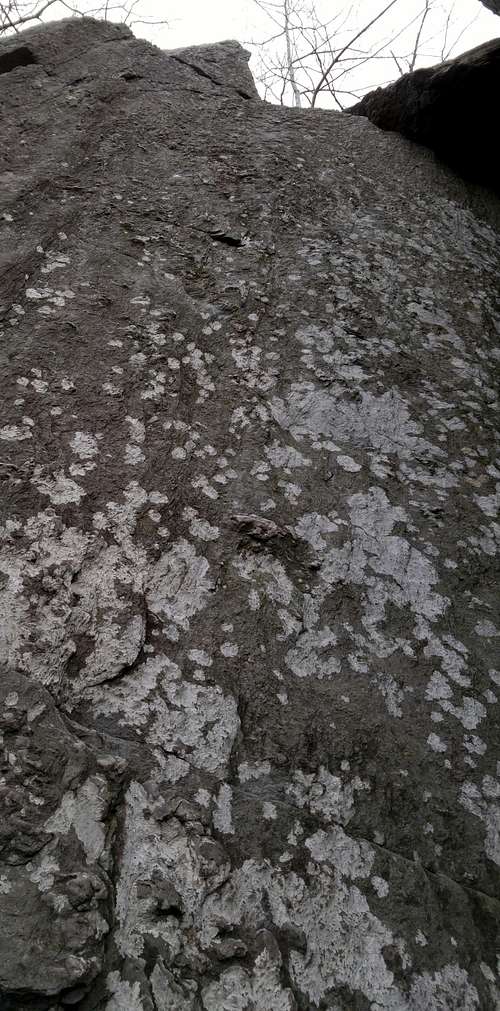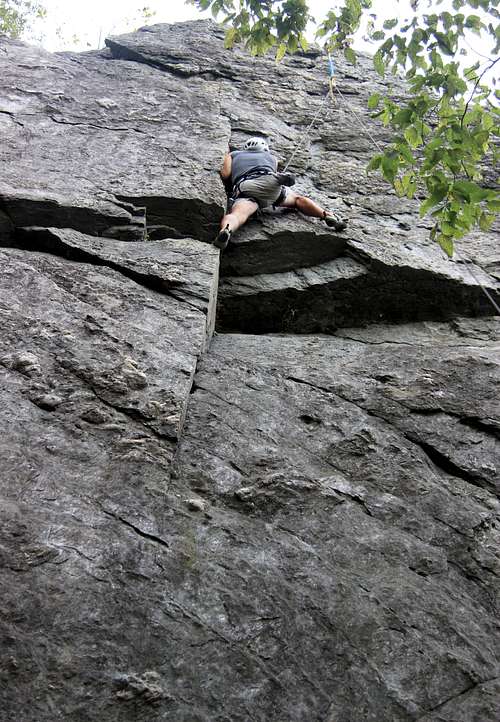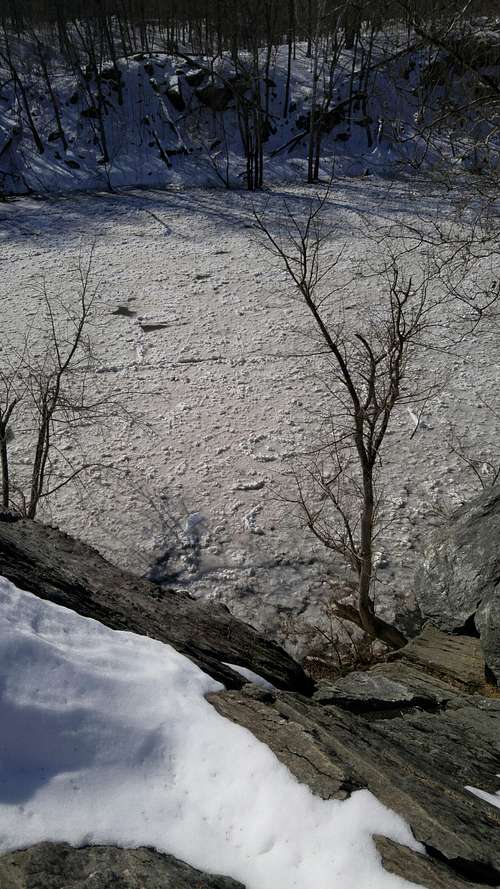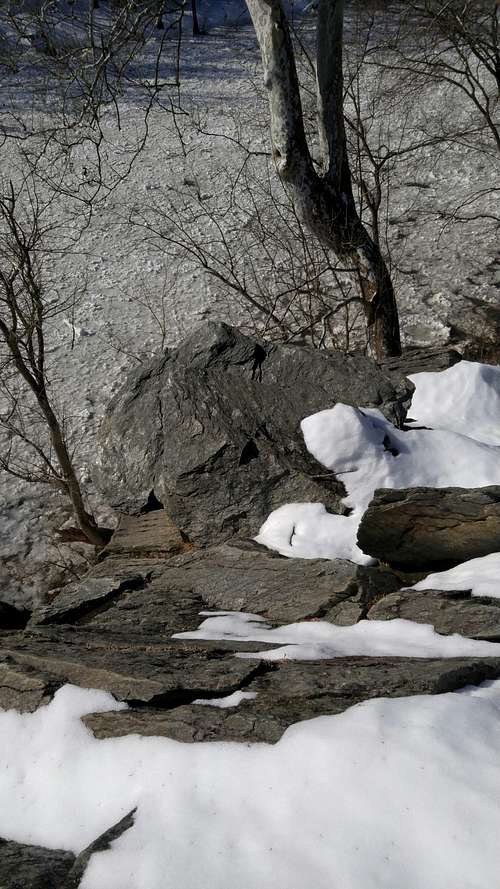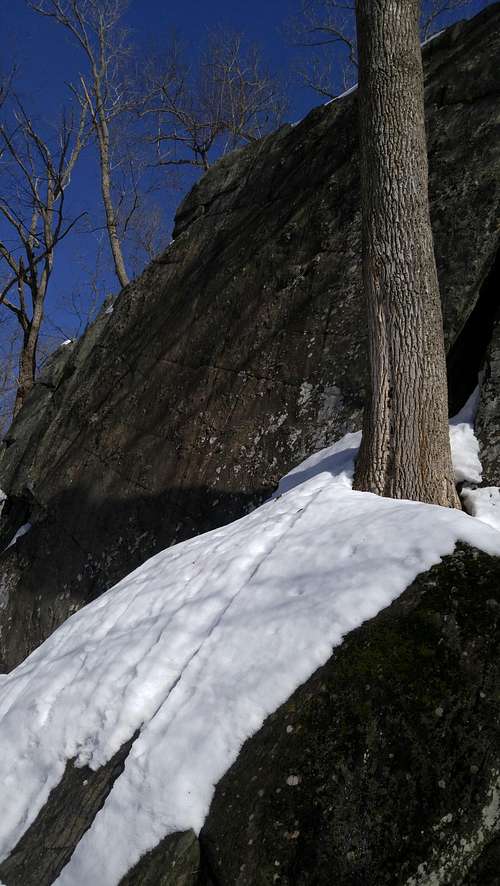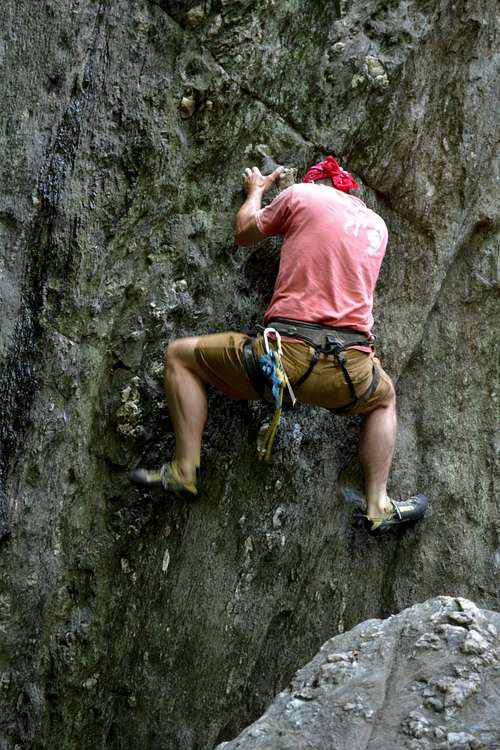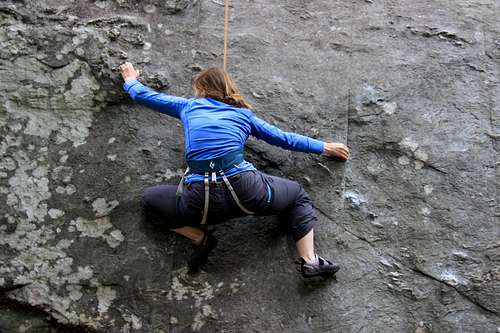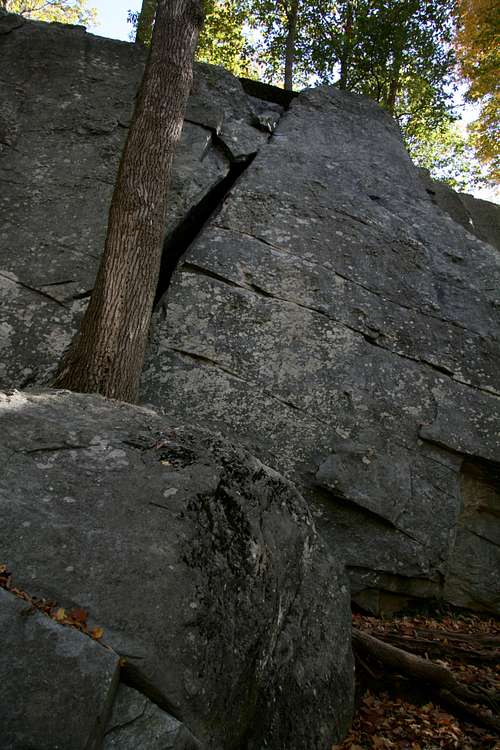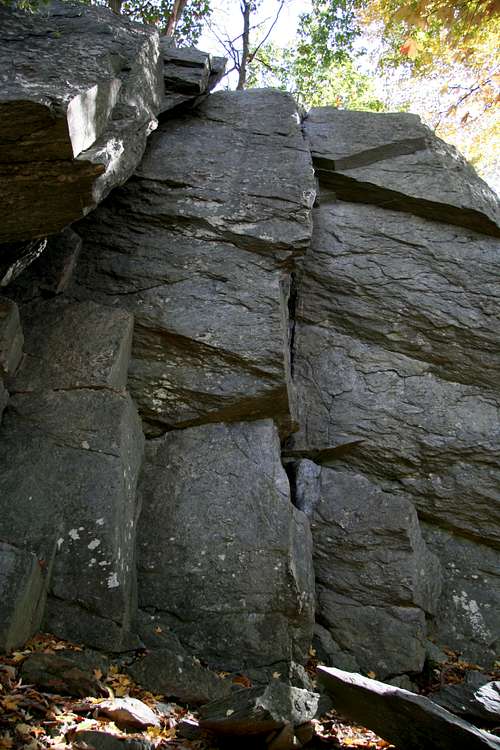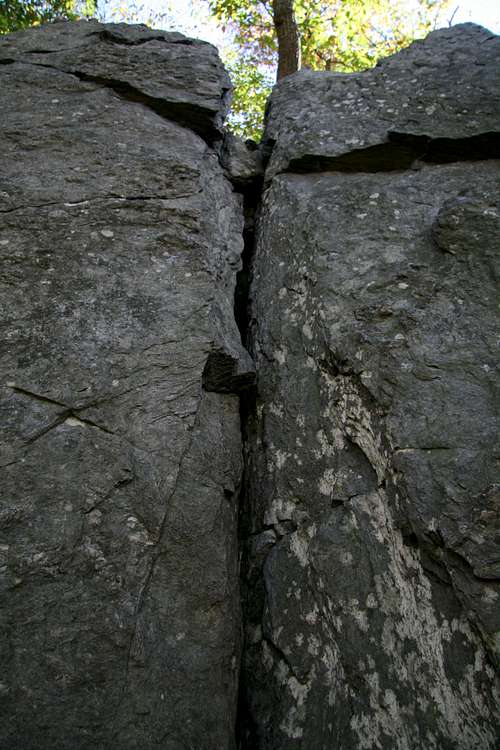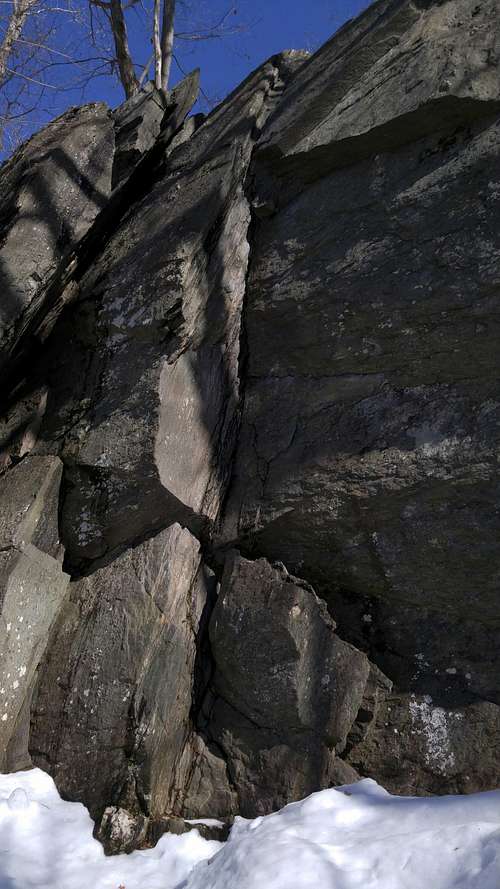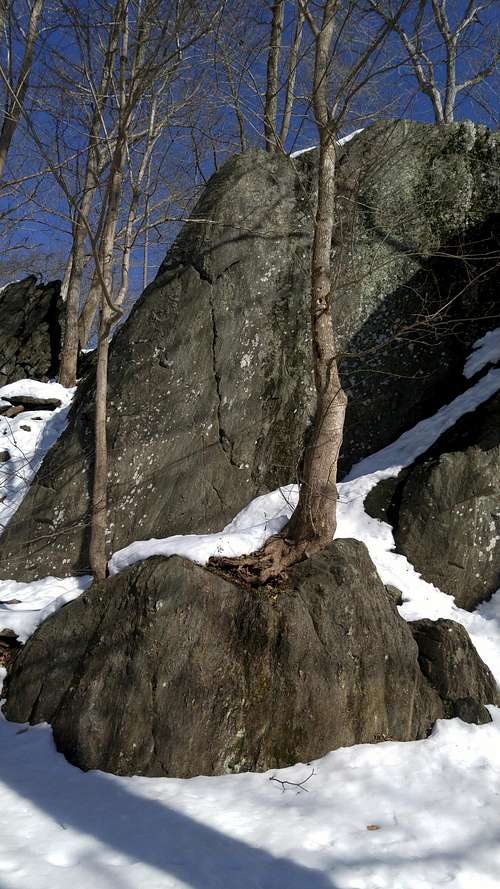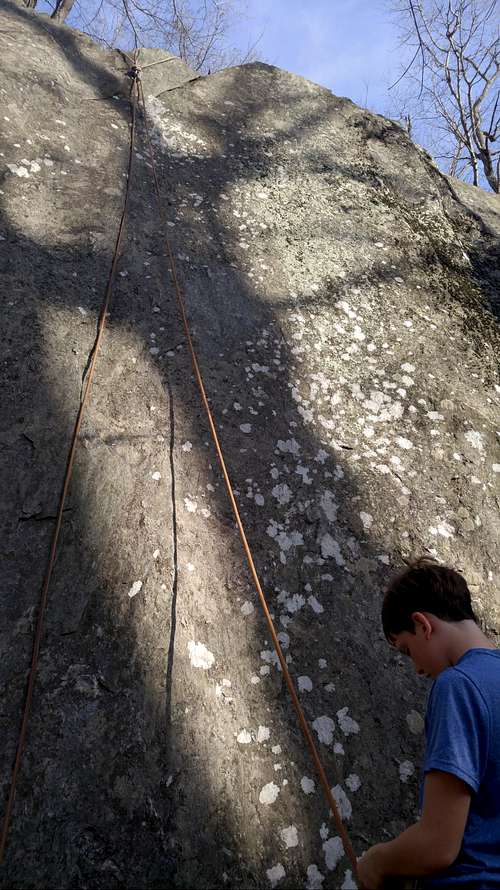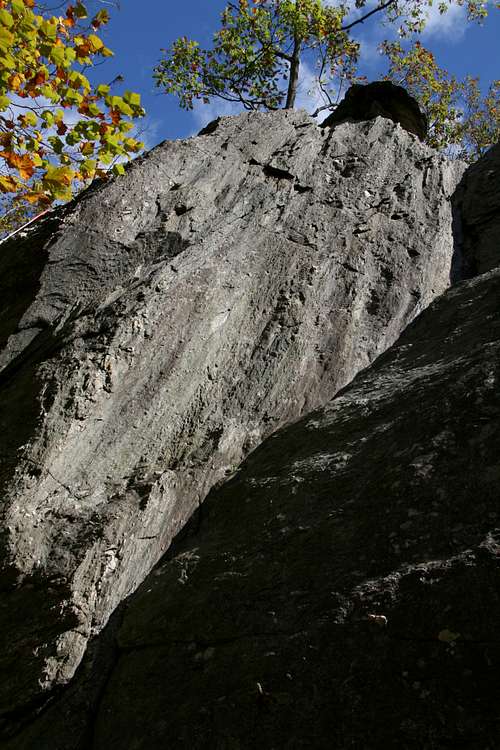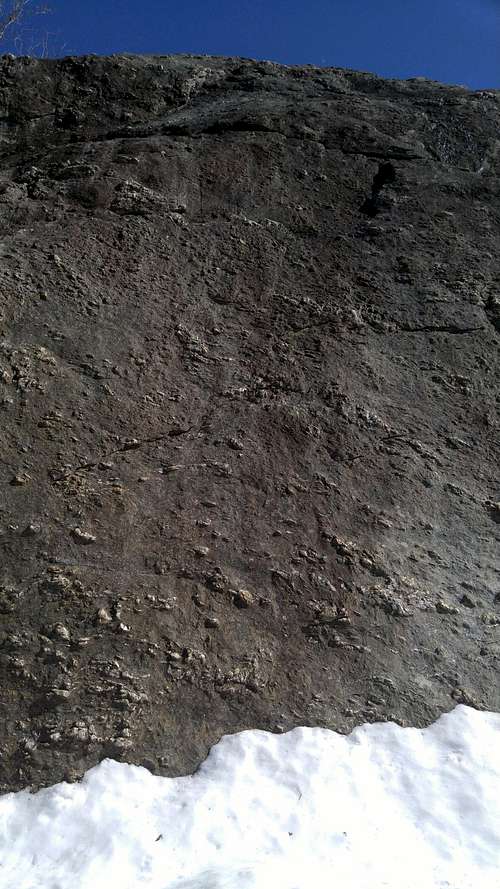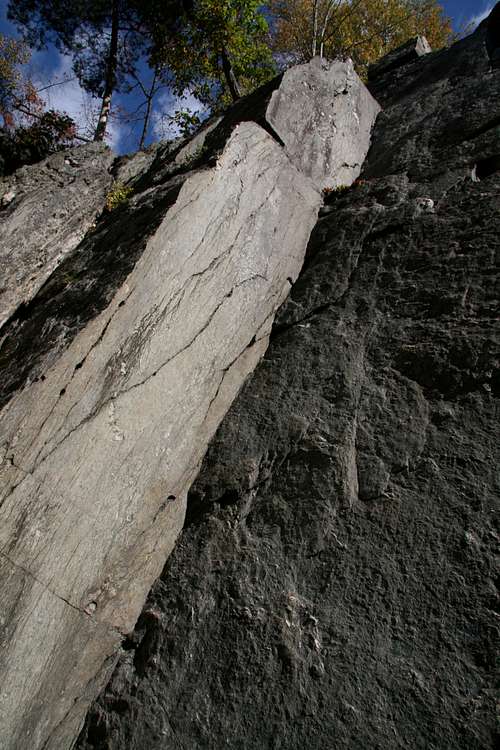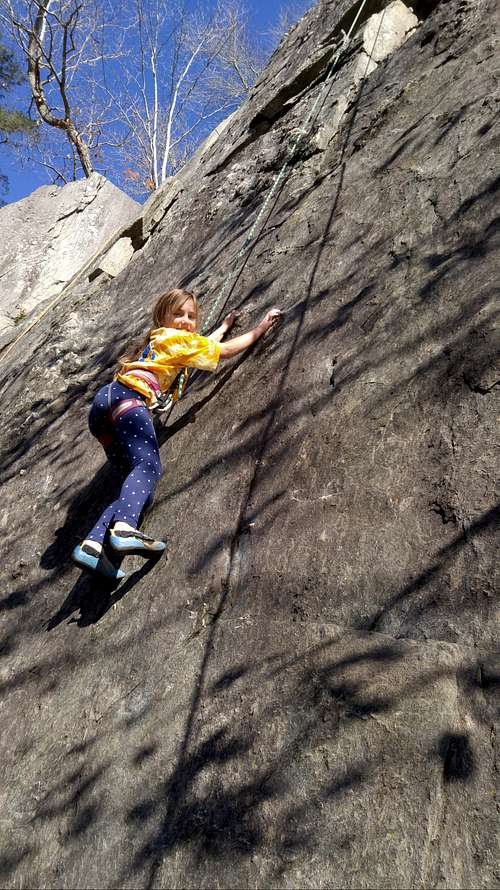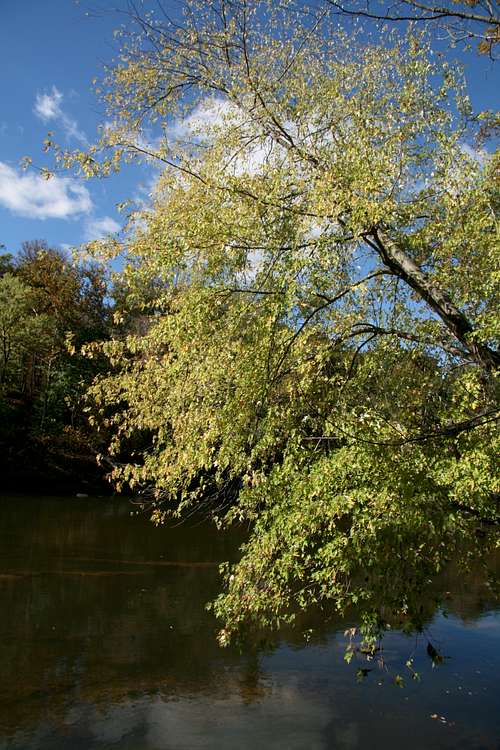-
 26827 Hits
26827 Hits
-
 85.87% Score
85.87% Score
-
 21 Votes
21 Votes
|
|
Mountain/Rock |
|---|---|
|
|
38.97583°N / 77.20694°W |
|
|
Trad Climbing, Toprope, Bouldering, Scrambling |
|
|
Spring, Summer, Fall, Winter |
|
|
101 ft / 31 m |
|
|
Carderock
When I originally posted this page in 2007, I had very little experience on a rope, and almost all of my Class 5 climbing had been free soloing easy routes. Now I have reconstructed it from a climber's perspective, not a scrambler's.
Carderock is probably the most popular climbing spot in the Washington, D.C. area. Fast access from the nearest highway and even faster access from the parking area, plus dozens of clean, well-established routes of all types and difficulty levels (up to 5.13b), make it so. In addition to all that, the spot is popular with climbing classes and outings for companies, clubs, and school and church groups. Better climbing on more crags with longer routes and smaller crowds can be found a short drive away on the Virginia side of Great Falls, but Carderock endures as the region's favorite climbing destination and is still a nice place to climb. Just don't be surprised if you show up on a nice afternoon and find that all the best routes already have ropes on them.
The cliffs here get up to 60' in height, but most climbs are in the 40-50' range. Despite that and the fact that Carderock is primarily a toproping area, the climbing is not easy for its type (single-pitch leads and topropes). Schist is the predominant rock type here, and it is slick. Although there are several cracks and corners, the majority of the routes are face climbs. And when you also consider that the popularity of the area results in the holds, especially the starting ones, getting a bit smoother each year and that many routes were rated before YDS expanded beyond 5.9, you begin to see why the area has a reputation among many climbers for sandbag ratings. Most of the ratings have been corrected, but if you climb here, you still may find yourself thinking the route is at least a grade harder than its rating, even on a toprope. "Carderock 5.7" is often said with a wink, and just about every Carderock Route from 5.0 and even into the 10s feels one or two grades harder to most people used to climbing elsewhere.
Further complicating climbing here is that the ground features a lot of loose dirt and sand. Keeping shoes clean can thus be a problem, and many people bring a carpet swatch or a tarp with them.
Carderock is a year-round crag; even winter afternoons can be nice since the cliffs face southwest and can warm up nicely throughout the day. Fall is the nicest time to climb, and summer is probably the least pleasant (after cold winter days); the summer humidity makes both the rock and climbers slippery.
Carderock is a year-round crag; even winter afternoons can be nice since the cliffs face southwest and can warm up nicely throughout the day. Fall is the nicest time to climb, and summer is probably the least pleasant (after cold winter days); the summer humidity makes both the rock and climbers slippery.
The Crags
Carderock consists of two main crags: Jungle Cliff and Hades Heights. It was my original intent to make an area/range page for Carderock and separate mountain/rock pages for Jungle Cliff and Hades Heights, but I came to see doing all that as unnecessary.
A Class 3 gully (often used to access the crags) splits the two main crags and thereby defines them. Jungle Cliff, the northern crag, turns into a diminishing rock pile at its northern end. Hades Heights, for climbing purposes, runs south to where the Potomac River meets the cliffs, but the rock actually continues beyond that point for a short distance, and there are a few routes that now typically can only be reached via rappel or by a sketchy traverse over the water.
Combined, Jungle Cliff and Hades Heights have more than 60 routes in an area whose length you can walk in about five minutes (another reason the spot can seem so crowded).
A Class 3 gully (often used to access the crags) splits the two main crags and thereby defines them. Jungle Cliff, the northern crag, turns into a diminishing rock pile at its northern end. Hades Heights, for climbing purposes, runs south to where the Potomac River meets the cliffs, but the rock actually continues beyond that point for a short distance, and there are a few routes that now typically can only be reached via rappel or by a sketchy traverse over the water.
Combined, Jungle Cliff and Hades Heights have more than 60 routes in an area whose length you can walk in about five minutes (another reason the spot can seem so crowded).
Jungle Cliff is farther back from the river and thus less likely to have water at the base if the river is high. One notable disadvantage is that the routes tend to be shorter; many are only 25'.
Hades Heights, in addition to having taller cliffs, gets more sun. This is great in the winter but not so great in the summer. Having less shade, though, Hades Heights dries out faster after a rain, and the routes themselves feel drier in general, though there are some routes with starts that are crazy-smooth.
History
Carderock has a storied history, as it was one of the first Eastern crags to be developed, and many of the pioneer climbers there bore names that have gone down into legend. Perhaps most significant among them were Herb and Jan Conn, who made many first ascents here, in the Northeast, and at the fabled Seneca Rocks in West Virginia before moving west. Their names live on at Carderock and Seneca and many other places. Carderock alone has Herbie's Horror, the country's first 5.9 and thus once the country's hardest climb, and Jan's Face, a long wall with variations from 5.3 (not really a 5.3!) to 5.11d.
The Conns and their contemporaries climbed in the days of hemp ropes and boots, making ascents that today must be far easier given the advances in gear. For example, anyone solid at 5.9 and wearing nice new climbing shoes probably will not find Herbie's Horror that difficult, but imagine it in boots!
Climbing Styles
First, there is no sport climbing here. A few old bolts remain on a couple lines, but you would be crazy to trust them. Local ethics (and regulations) prohibit bolting. On several routes, you can see where bolts were chopped.
Trad-- Trad at Carderock and Great Falls is a contentious issue. Carderock really does not have many leadable lines (I will cover some in the next section), though Great Falls does. Rock quality is the issue. For the most part, the rock out here is clean and solid (though on some routes you may grab a flake and find yourself terrified when it moves), but often slick. But it is a schist that has been known to do one of two things under great force, i.e. the type exerted by a fall, especially on a cam: simply break, or grind small crystals just enough to create a fine powder that causes a piece of pro (again, especially a cam) to skate out. A notorious example was the time someone on the Virginia side was leading the classic, very pumpy 5.9 Armbuster. Near the topout, he fell, his gear failed, and he decked, injuring himself so badly that he gave up climbing.
Nevertheless, there are still some good leads at Carderock, but play it safe and use passive pro. Better for your follower to curse and fiddle with the nut tool than for you to fall and die. Before I read up on this subject, I had used cams plenty of times in this area but luckily had never fallen on one. After reading up on it, I switched to passive. I have fallen three times on passive pro out here, twice at Carderock and once at Great Falls, and the pro, stoppers in all three cases, held.
For more on the subject of leading at Carderock and Great Falls, check out this great post that I found. You can also find some back-and-forth arguments in the forums at Mountain Project.
Toproping-- This is what just about everyone does here. The numerous trees and boulders make it quick and easy to set up anchors.
Bouldering-- Plenty of opportunities here. The local guidebook describes several problems. It's also common to see people out just working the opening moves of various climbs. In fact, I bought a crash pad for just that purpose.
Traversing-- Traverses at Carderock are quite popular; don't be surprised to be hangdogging on toprope, trying to figure out the move, and then see some guy creeping across the face 10 feet below you. The classic Carderock traverse is along Hades Heights, but there are others, both low and high.
Getting There
From I-495, take Exit 41, just north of the Potomac River, heading west on the Clara Barton Parkway. In about a mile, take the exit for Carderock. Go left over an overpass and turn right at the stop sign. Drive to the last parking lot.
A sign near the now-closed restrooms indicates the way to the Billy Goat Trail. You can follow the trail as it winds around the north end of the cliffs and reaches the base area, or you can descend the easy, obvious gully that divides Jungle Cliff from Hades Heights.
It should take no more than five minutes to get from your car to the crag.
A sign near the now-closed restrooms indicates the way to the Billy Goat Trail. You can follow the trail as it winds around the north end of the cliffs and reaches the base area, or you can descend the easy, obvious gully that divides Jungle Cliff from Hades Heights.
It should take no more than five minutes to get from your car to the crag.
Routes
As I mentioned already, there are more than 60 routes here. I'm not going to name them all. Instead, I will list and describe routes I recommend. This is based on factors such as popularity, sustained climbing at the grade, and pure fun. In all cases but one, I have climbed the routes I recommend either on toprope or lead.
I will separate them first by crag and then by toprope or trad. They are listed from left to right.
Jungle Cliff
Remember, this is the one on the left as you face the cliffs from the bottom.
Toprope
- Herbie's Horror (5.9)-- The first 5.9 in the country and once its hardest climb. FA by Herb Conn. During an NPR interview at Carderock, Chris Sharma climbed this and agreed it felt like 5.9. So climb this one and know that you have shared the rock with a famous old-school climber and the world's best rock climber (as I write this). How cool is that? Plus, if you climb it without using the cheat hold that locals say Sharma used and which he seems to reach for in the video, you can claim you're better than Sharma. ;-)
- The Flake (5.10b)-- Near the left end of Jan's Face, find three incipient cracks running straight up the wall. The Flake stays between the left and middle cracks. You can use holds on the cracks, but not outside the cracks (Carderock has several "eliminate" and contrived routes). If you use the big holds to the left near the start, the route becomes 5.9; when you see this one rated such in some sources, that is why. The non-cheat start is hard, almost as hard as the crux, which is about 2/3 of the way up on small and slippery holds. Actually, and maybe it's my personal technique or body type, I have found this crux more troublesome than I have found the crux on Eight Ball, a 5.11d and the next climb over.
- Eight Ball (5.11d)-- This one goes between the middle and right seams near the left end of Jan's Face. Really, there are only two really hard parts on this climb, and they are about equal in difficulty, though the rest is not exactly easy. First is the start, which supposedly was easier before a hold broke off. It helps to be tall for this one. With my crash pad below me one day, I got the start dialed, but if you see me cruising it, don't be fooled; it is hard. The official crux is, as on The Flake, about 2/3 of the way up. It's a balance move you have to make without using the obvious and good hold to the right that is just inches off-route. This climb and Eight Ball are balancy and technical, not steep and strenuous.
- Center Face (5.6-5.8)-- There is a big tree at the base of Jan's Face. Climb anything between it and the seams defining The Flake and Eight Ball.
- Sterling's Crack (5.7)-- A classic "Carderock 5.7"; many will say it's 5.8. Anyway, the moderate grade, the length, and the fun jams/laybacks/holds make this probably the best crack climb at Carderock. This one gets wet when it rains and stays that way for a few days. If you want to climb this, wait for several dry days in a row and then go very early or very late.
- The X (5.7)-- Just left of Barnacle Face, four cracks form an X. This was my first "eliminate" climb at Carderock, done solo. To do it correctly, don't use the holds along the cracks.
- Barnacle Face (5.3)-- Only 30', this can be done as a bouldering problem if you're willing to risk that fall. Although it's easy, it's a lot of fun, and a great introduction to face climbing at Carderock. It's a pain setting up a toprope for this one, though.
- The Diamond (5.8)-- This is just left of Beginner's Crack. Not considered an area classic, I still like this one. Don't use the big flake at bottom left and don't use the huge one to the right at all. Higher up, there is a small roof, and there are at least two different good ways to pull it.
- Beginner's Crack (5.3)-- Unless you're used to laybacking, you won't think this is 5.3, as it will feel harder. Actually, it's more a massive flake than a crack. This might be the most popular climb at Carderock.
- Beginner's Face (5.4)-- Just to the right of the crack. Easier than it looks, and fun.
Trad
I have led three routes on this crag.
- Jam Crack (5.2)-- This is a popular TR route for classes and beginners. It is a little left of Herbie's Horror and goes up a face and then finishes up a huge crack. The first half is runout but easy. Then there is a big step over a gap, and that step scares off some climbers. Finally, there is the crack. You need huge cams for this, and cams are suspect in this rock. Don't fall!
- Sterling's Crack (5.7)-- This is a tough lead for the grade because it is steep and does not have good stances or pro where the climb is hardest. Not recommended for someone breaking into leading 5.7.
- Beginner's Crack (5.3)-- I don't remember what I used the first time I led this. Probably, it was as desperate a lead as it was the second time. The second time, knowing how unreliable cams are in the rock here, I left the big cams in my pack and climbed with hexes and stoppers. I got some pieces in early, but then the "crack" (really a flake) got so huge that probably only the larger Big Bros, and maybe a #6 C4, would fit, so it was all runout until near the top where I finally got a stopper in and felt some relief. Was I going to fall on a 5.3 that really is more like a 5.5? Probably not, but you never know. I was happy to get that high stopper in.
Hades Heights
This is the taller, sunnier cliff to the climber's right after descending the gully and turning to face the cliffs.
Toprope
- Kindergarten (5.0)-- The first obvious route, super-easy. If you have little kids you need to indoctrinate or older noobs you need to instill false confidence in, do it.
- Spider Webb (5.7)-- Also called Spider Crack. It's a short but fun (and stiff for the grade) crack route, with a finish up an easy face. Fun fact: I have climbed 10d and 11d and 12a here clean but have only gotten this one clean once; my fingers are just too big for the crack at the spot where I usually come off. But after finally getting it clean, I think I have the footwork down to compensate for the marginal fingers.
- Silver Spot (5.13b)-- Currently the hardest-rated climb at Carderock, though not all agree that it's actually the hardest. Still, it's desperate. Really, I did not enjoy this climb, which involved several falls and prodigious profanity, but I'm listing it here out of spite since I did get it in the end.
- Green Bucket (5.10b)-- On some sites, people call this 5.9. I think they are climbing it incorrectly, going up the center or even the right side of the face before reaching up and grabbing the "green bucket," which is really a depression but a good hold nonetheless. If you go up the left side to the overhang, following the thin crack, which is keeping in line with the local beta, it is definitely harder than 5.9.
- Golden Staircase (5.7+)-- Because of the swing potential on toprope, I don't really like this climb, but it is popular and it is fun if you hang on. Start left of The Crack and climb the face without using the crack. Ascend to and through a yellowish section that gives the route its name.
- The Crack (5.3)-- Easy to find. It's the nice crack in the corner between Golden Staircase and Nubble Face. The direct start is harder than 5.3, more like 5.8.
- Nubble Face (5.3-5.5)-- The broad face between The Crack on the left and a big bulge/overhang to the right. Much like Jan's Face but easier and longer.
- The Bulge (5.10b)-- Climb to the big bulge right of Nubble Face. Pull it on good holds, without using the cheat holds on the right and left sides of the bulge, and then continue on thin holds to an easier finish. On some sites, this is a 5.9+.
- Incipient (5.9+)-- To the right of The Bulge is a roof. Climb it and then pull it; then follow the incipient crack to the top. Local rules say that anything more than 6" from the incipient crack is off; good luck with that. This is a solid 5.9. To the immediate left and right of the line are 5.10d routes; I think the one to the left is easier than Incipient, but the one to the right, a true one-move wonder, has a very hard move to get past the overhang without using the cheat arete holds to the right.
- Cripple's Crack (5.10c)-- This is the one route I'm recommending without having climbed it, though I have climbed its very close variation, Cripple's Face (10b). You're supposed to use the diagonally ascending crack system. Because of the diagonal nature of this and Cripple's Face and because the route is long by Carderock standards, setting up a toprope is very difficult for this one (not to mention it's hard to do because of the terrain up top). Set it too far to the middle and you'll be higher than the anchor at some point; set it above the finish and you're guaranteed a big swing if you fall early or even in the middle, and that swing could easily be injurious because of what's in the neighborhood. This one is probably best for climbers already solid at the grade.
- Butterfly (5.9)-- A very popular route. Climb the corner without using any holds in the corner or on the wall to the left. The holds are small and slick until you reach a bomber undercling, after which things get a lot easier. Before that, this is a very tough 5.9.
- Merv's Nerve (5.10c/d)-- Climb the face between Butterfly and Easy Layback, not using holds on either. There are two cruxes; one is about a third of the way up, and the second is below the finish (don't use the crimp to the left if you want to keep the 10 rating and understand why it's said that this is an 11 for shorter climbers). Like many other hard Carderock face climbs, this is not strenuous but is instead very technical, requiring very precise toes and fingertips.
- Easy Layback (5.4)-- Super-popular route and many a Carderock climber's introduction to the crag. The early going feels stiff for the grade.
- Eliminates (5.7)-- The face to the right of Easy Layback. Several variations are possible. This is a classic "Carderock 5.7" that will feel 5.8 to many.
- Fingernail (5.10b)-- To the right of Eliminates is a hairline crack going up to a ledge and overhang. Follow that hairline crack. I have seen people drift way left or right when climbing this; that makes it 5.7 or 5.8. This is one of my favorite climbs at Carderock, as it is one of the longest and involves a nice mix: technical foot- and finger-work, laybacking, some crack, and an overhang.
- Zig-Zag (5.12a/b)-- Follow the Z-shaped system of incipient cracks, using no large holds off the cracks. After the crack system is over, finish how you like, as the 5.12 part is done. This is balancy and technical, not strenuous, making it an "easy" 12, if such a thing exists.
- Triple A (5.8)-- Climb an obvious flake (terrible feet for this), pull onto a ledge, and then use jugs to get through an overhanging wall to the top. This might be the longest vertical climb at Carderock. The flake is really thin and weak at its top, and it is going to break off there sooner rather than later, making this climb at least a grade harder.
- Trudie's Terror (5.8)-- The last route before the walkway at the base ends and the cliff goes straight into the river. Jam or layback the crack and then finish up the easy face. The trusted local guidebook calls this 5.8, and another respected guidebook calls it 5.4. It is harder than 5.4 but easier than 5.8, so just go with 5.6 in mind.
Trad
Hades Heights has a handful of leadable lines.
- Spider Walk (5.7)-- I have only toproped this lovely crack and cannot speak to the gear needed, but the crack would obviously take pro. The finish, though short, is on an unprotectable face.
- The Crack (5.3)-- This one eats pro from start to finish, though the tricky start makes it a challenge to get that first piece in. In my opinion, this is the best lead at Carderock. The finish is tough as well for the grade, and it was on that finish that I fell twice one day when a key foot placement was wet, and it was there I learned to trust bomber passive placements. Most topropers do not top out and therefore miss the spice of the finish.
- Cripple's Crack (5.10c)-- All I know is that it has been led and that it is beyond my current ability to lead.
- The Laundry Chute (5.1)-- Very easy, often scrambled. Really a waste of time except for true beginners.
- Easy Layback (5.4)-- The placements on this one are so-so because the crack and flake are irregular.
- Trudie's Terror (5.6ish)-- The long crack screams for pro; just be aware that the last 10-15' will be on a run-out slab, though I have gotten a marginal hex placement in there.
Red Tape
No admission fees, but the area is on NPS land and all regulations for C&O Canal NHP apply (see links section).The park closes at dark. Do not alter the rock in any way to place gear. Beware poison ivy and copperheads.No fees. Read posted regulations.
When to Climb
All year. The cliffs face west. Summers are hot and humid, so you want to climb early before the sun hits the rock. Winter afternoons can be awesome; climb in short sleeves even though it's in the 40s because the sun radiates off the rock, with the dry air making the slick holds a little better. Spring and fall are best but also the most crowded.
Camping
None.
External Links
C&O Canal NPS site
An excellent resource for the area is Eric Horst’s Rock Climbing Virginia, West Virginia, and Maryland. The section on Carderock provides photographs and one-sentence overviews of the routes.
A better guidebook is Carderock Past and Present, published by PATC (Potomac Appalachian Trail Club). The PATC guide fits nicely into a pack pocket and is full of excellent photographs that help locate the routes.
An excellent resource for the area is Eric Horst’s Rock Climbing Virginia, West Virginia, and Maryland. The section on Carderock provides photographs and one-sentence overviews of the routes.
A better guidebook is Carderock Past and Present, published by PATC (Potomac Appalachian Trail Club). The PATC guide fits nicely into a pack pocket and is full of excellent photographs that help locate the routes.


